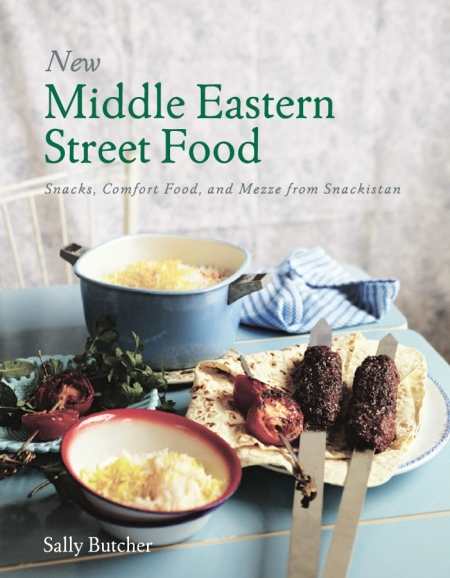New Middle Eastern Street Food
Snacks, Comfort Food, and Mezze from Snackistan
Butcher’s lively gastronomic notebook reveals as much about her neighborhood and travels as it does about cuisine.
Sally Butcher is the colorful owner of Persepolis, a Persian deli situated in London’s international Peckham district. Drawing from decades of restaurant cooking experience, she invites readers to Snackistan, an imaginary region encompassing the Middle East, Greece, part of Africa, and the Levant. With a humorous, chatty approach to bringing street foods and mezze-style menus to the inspired palate, this gorgeously designed book features full-color photographs and recipes both creative and indulgent. For the epicurean, for the ambitious cook, for the simply curious, Butcher’s tribute to the art of grazing provides an entertaining introduction.
Also the author of Veggiestan: A Vegetable Lover’s Tour of the Middle East, Butcher takes an informal look at regional favorites, supplementing recipes with extensive personal anecdotes; tidbits on the origins of certain foods; brief stories that feature the character Mullah Nasruddin, whose adventures offer unique perspectives on the pleasures of dining; and mentions of family and friends. The result is a lively gastronomic notebook that reveals as much about Butcher’s neighborhood and travels as it does about cuisine.
Despite its title, the book is not intended to highlight hand-held foods with minimal preparation. Though some items, such as kebabs, are classic street food, and others, such as yogurt- and legume-based dips, spiced nuts, and pickled vegetables, require little effort, most selections honor attention to detail. Several entries in the chapters “Fishy Things,” “Meat on Sticks,” and “Meat Not on Sticks” are also expandable as main courses that span home-style comfort foods (mashed lamb with stock) as well as guest-worthy presentations (Afi’s lamb roulade).
Specialized traditional equipment, such as flat rather than thin skewers, remain optional—Butcher thoughtfully provides alternatives. She does not shy from authenticity, however, when it comes to ingredients. A few recipes call for items US readers may find tougher to purchase in the average market (a pig’s head, brains), but these offer determined cooks a welcome challenge. The majority of recipes remain accessible. Simple accompaniments that rely on thoughtful spice combinations—cabbage with sumac, red lentils with berbere—or pairings of savory and sweet, including lamb-stuffed prunes and fried watermelon with cheese, provide ample choices.
For readers who do not mind recipes presented as dense narratives, this is a fascinating tour of one writer’s Persian household and long-standing love of Middle Eastern foods.
Reviewed by
Karen Rigby
Disclosure: This article is not an endorsement, but a review. The publisher of this book provided free copies of the book to have their book reviewed by a professional reviewer. No fee was paid by the publisher for this review. Foreword Reviews only recommends books that we love. Foreword Magazine, Inc. is disclosing this in accordance with the Federal Trade Commission’s 16 CFR, Part 255.

